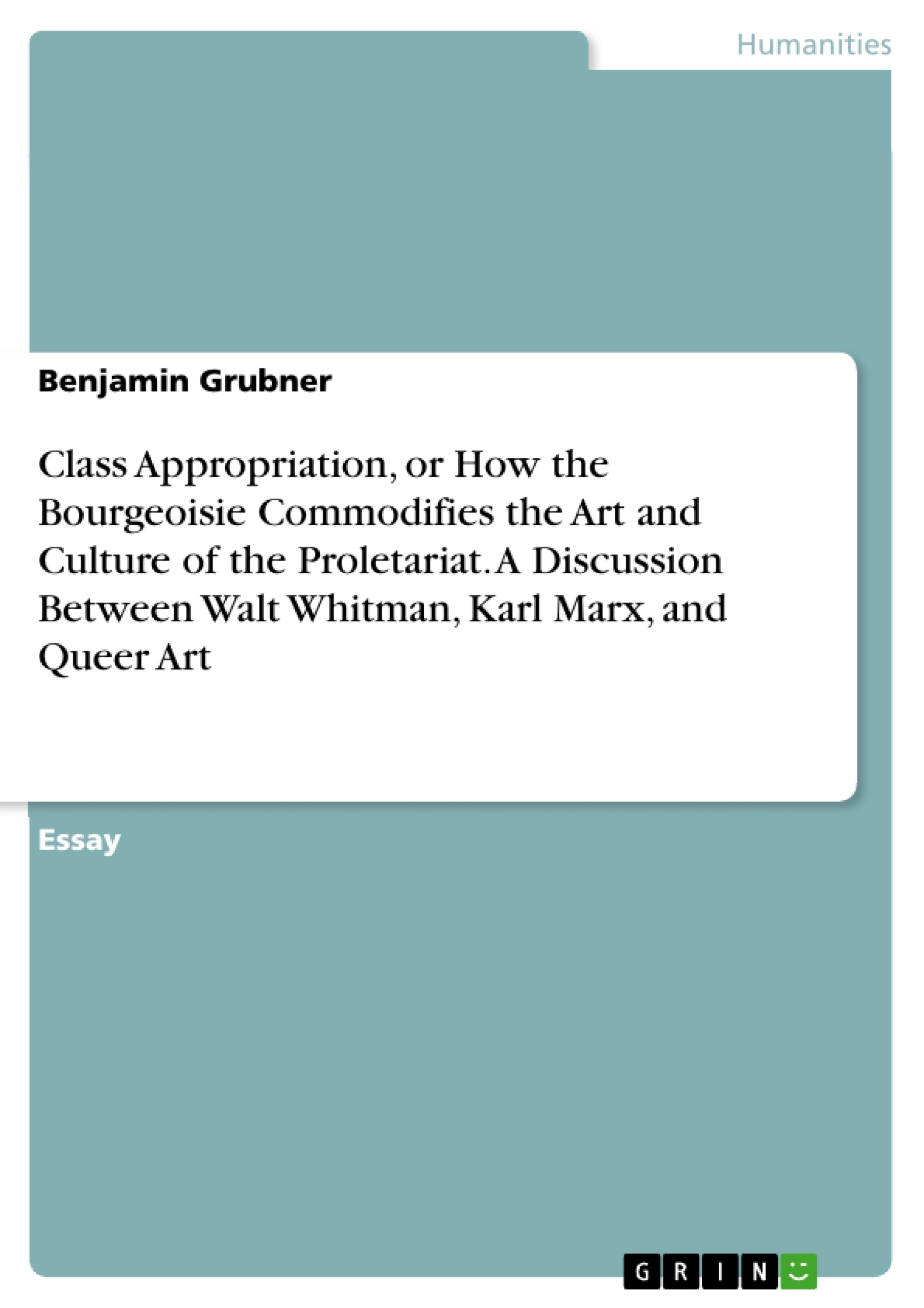I seek to reveal the complex relationship between the bourgeois business world of art and the proletariat artist. Furthermore, I will be commenting on the appropriation and erasure of minorities by those who fetishize art merely for the sake of inflating their own visage of wealthiness. I will do this through a detailed reading of Karl Marx’s Manifesto of the Communist Party alongside the discussion of Walt Whitman tied with an analysis of the works of queer artists, such as Andy Warhol and Robert Mapplethorpe.
Inhaltsverzeichnis (Table of Contents)
- Class Appropriation, or How the Bourgeoisie Commodifies the Art and Culture of the Proletariat, A Discussion Between Walt Whitman, Karl Marx, and Queer Art:
Zielsetzung und Themenschwerpunkte (Objectives and Key Themes)
This paper examines the complex relationship between the bourgeoisie and the proletariat within the art world. It analyzes how the bourgeoisie commodifies the art created by the proletariat, leading to the alienation of the artist and the erasure of proletarian culture. The paper uses the writings of Karl Marx and Walt Whitman, along with an analysis of queer artists like Andy Warhol and Robert Mapplethorpe, to illustrate this dynamic.
- Commodification of Proletarian Art by the Bourgeoisie
- Alienation of the Proletariat Artist
- The Role of Art as a Tool of Production and Unity
- The Art-Capitalist Complex
- The Erasure of Minority Cultures in the Art World
Zusammenfassung der Kapitel (Chapter Summaries)
Class Appropriation, or How the Bourgeoisie Commodifies the Art and Culture of the Proletariat, A Discussion Between Walt Whitman, Karl Marx, and Queer Art: This chapter explores the intersection of Marxist theory, the poetry of Walt Whitman, and the work of queer artists to analyze the commodification of art by the bourgeoisie. It argues that the bourgeoisie's control over capital extends to the art world, where the proletariat artist's work is exploited and alienated from its original meaning and purpose. The author uses Marx's concept of alienation to demonstrate how the capitalist system dehumanizes the artist, turning their creative expression into a commodity for profit. Whitman's poetry, particularly "Crossing Brooklyn Ferry," is introduced as a counterpoint, highlighting the potential for art to create unity and shared experience, despite the alienating forces of industrial modernity. However, the chapter argues that the bourgeoisie appropriates this unifying power, turning art into a tool for further commodification and reinforcing the cycle of alienation. The work of queer artists like Warhol and Mapplethorpe is then analyzed to illustrate how minority artists' work is particularly susceptible to appropriation and erasure by the dominant culture.
Schlüsselwörter (Keywords)
Bourgeoisie, proletariat, art commodification, alienation, queer art, Marxism, Walt Whitman, Andy Warhol, Robert Mapplethorpe, capitalist exploitation, class struggle, cultural appropriation.
FAQ: Class Appropriation, or How the Bourgeoisie Commodifies the Art and Culture of the Proletariat, A Discussion Between Walt Whitman, Karl Marx, and Queer Art
What is the main topic of this paper?
This paper examines the complex relationship between the bourgeoisie and the proletariat within the art world, focusing on how the bourgeoisie commodifies proletarian art, leading to artist alienation and the erasure of proletarian culture.
What theoretical frameworks are used in this analysis?
The paper utilizes Marxist theory, specifically Karl Marx's concept of alienation, alongside the poetry of Walt Whitman and an analysis of queer artists like Andy Warhol and Robert Mapplethorpe to illustrate the commodification of art.
How does the paper connect Marxism and art?
The paper argues that the bourgeoisie's control over capital extends to the art world, exploiting the proletariat artist's work and alienating it from its original meaning. Marx's concept of alienation is used to show how the capitalist system dehumanizes the artist, transforming creative expression into a commodity.
What is the role of Walt Whitman's poetry in this analysis?
Whitman's poetry, particularly "Crossing Brooklyn Ferry," serves as a counterpoint, highlighting art's potential to create unity and shared experience. However, the paper argues that the bourgeoisie appropriates this unifying power, using it for further commodification and reinforcing alienation.
How does the paper address queer art?
The paper analyzes the work of queer artists like Warhol and Mapplethorpe to demonstrate how minority artists' work is especially vulnerable to appropriation and erasure by the dominant culture.
What are the key themes explored in the paper?
Key themes include the commodification of proletarian art, the alienation of the proletariat artist, art's role as a tool of production and unity, the art-capitalist complex, and the erasure of minority cultures in the art world.
What are the key words associated with this paper?
Key words include: Bourgeoisie, proletariat, art commodification, alienation, queer art, Marxism, Walt Whitman, Andy Warhol, Robert Mapplethorpe, capitalist exploitation, class struggle, cultural appropriation.
What is included in this preview?
This preview provides the title, table of contents, objectives and key themes, chapter summaries, and key words of the paper.
What is the main argument of the chapter "Class Appropriation..."?
This chapter argues that the bourgeoisie appropriates proletarian art, exploiting it for profit and alienating the artist from their work. It uses Marxist theory, Whitman's poetry, and examples from queer art to support this argument.
- Quote paper
- Benjamin Grubner (Author), 2016, Class Appropriation, or How the Bourgeoisie Commodifies the Art and Culture of the Proletariat. A Discussion Between Walt Whitman, Karl Marx, and Queer Art, Munich, GRIN Verlag, https://www.grin.com/document/344751



